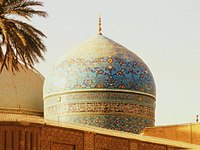Idrisiyya
It is also called the Tariqa Muhammadiyya, and it rejected following any of the four schools of Islamic jurisprudence (Taqlid),[2][3] adopting the same methodology as Ismail Dehlavi, who remarked that the agenda of the new order known as Tariqa Muhammadiyya was to purify Islam and reject what they deemed to be Bid'ah or Shirk.
[6][7] Originally based in Mecca, this tariqa was spread widely in Libya, Egypt, Sudan, Somalia, Eritrea, Kenya, Yemen, the Levant (Syria and Lebanon) and South East Asia (Malaysia, Singapore, Brunei).
[9] The order has a great deal of overlap with the Deobandis and Ahl al-Hadith of India,[2] but is opposed to the Wahhabi belief of affirming corporeality for God.
[10] The order's methodology has been opposed by al-Ahbash, who have declared that the Dandarawiyya path have fallen into blasphemy and no longer follow the Quran despite reading it.
[15] Unsurprisingly, the Idrisiyya has also been opposed by Barelvis, who see their methodology as being heretical, and similar to Deobandis and Ahl al-Hadith.

